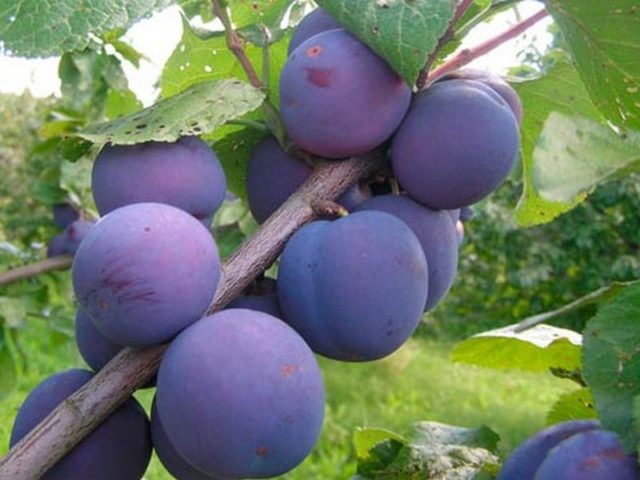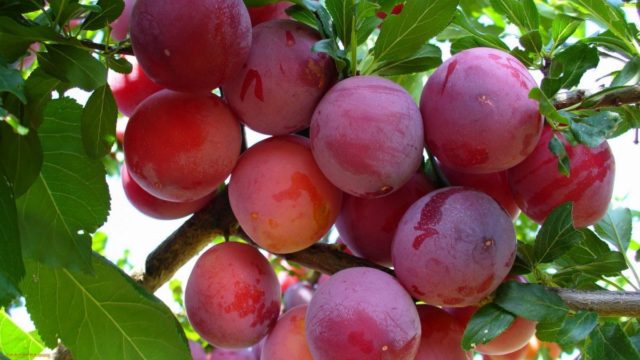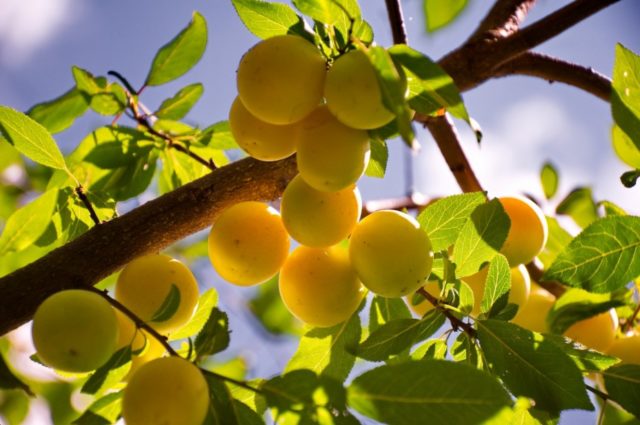Home plum is a type of fruiting plants from the genus plum, subfamily plum, family pink. These are short trees, living for about a quarter of a century, capable of producing crops for two-thirds of their life. Centuries-old selection has led to the emergence of an impressive number of varieties that differ in the appearance of the fruit, tree, taste, nutritional properties, ripening times, and the degree of resistance to diseases.
What a plum looks like
Around the end of the 3rd century BC, Theosphates described two types of domestic plum, cultivated at that time in the Greek territory. One of them was distinguished by especially sweet and juicy fruits.
Scientists believe that the home plum originated in Asia through extreme cross-pollination of wild thorns and cherry plums. From there, the tree was brought to Egypt and Greece, where they began to actively cultivate it.
Plum is a tree or bush
Shrubs do not have a main trunk. Several of their lignified shoots constantly replace each other throughout life: one dies off, and a new one immediately takes its place.
Whereas a tree with the onset of maturity has one main trunk. In addition, the growth of an already formed plant is much higher than that of a bush, whose size is from 0.6 to 6 m. A home plum is a tree with a main trunk and a fifteen meter growth limit.
Plum tree description
Home plum grows up to 15 meters, its height depends on the variety and climatic features of the area. For the same reasons, the crown of a plant is spreading, wide or narrow, extended upward. The root system, located mostly at a depth of 0.45 m, has a rod-like shape.
What are the leaves of the plum
Home plum leaves are arranged alternately on short petioles, up to 10 cm long, up to 6 cm wide. The edge is serrated, the plate is wider at the base, narrows towards the end and becomes sharp. The reverse side of the leaf is slightly pubescent. The color changes in the fall: from summer green to pale yellow.
How plum blooms + photo
Each flower bud has a simple shape and produces up to 3 white or pinkish buds with a diameter of 1-2.5 cm. Plum flowers are collected in bunches or grow alone.
Their structure is usual:
- 5 sepals of green color;
- 5 petals white or pink;
- 23-30 stamens;
- 1 pistil, superior ovary.
The flowering period occurs in April in the southern regions, in May - in the middle lane, at the beginning of June - in the Urals and Siberia.
Plum tree fruits
The fruit of the home plum tree cannot be classified as a fruit or a berry. Scientists define it as a drupe. Inside the fruit there is one large bone, flattened on both sides, with sharp ends. There is a lot of juicy and sweet pulp around the bone, covered with a thin dense skin with a smooth structure.
Drupes of home plum are varied in shape, taste and color, which depends on the variety. These can be round or oval fruits, colored in red, green, blue or yellow shades.
Homemade plum is rich in useful properties:
- lowers blood pressure;
- has a positive effect on kidney function;
- has a laxative effect;
- able to cleanse the body of cholesterol and toxins.
The drupe contains useful substances:
- potassium, fluorine, sodium;
- proteins;
- alimentary fiber;
- carbohydrates;
- vitamins B, C, B2, E, PP.
For a long time, homemade plums have been used to relieve the symptoms of gout and rheumatism, heart ailments and metabolic disorders.
Where the plum grows
Thanks to selection, home plum can grow and bear fruit in different latitudes and climatic zones. Varieties have been created that are adapted to the most severe conditions.
Historically, the geography of growing domestic plum is determined from the eastern part of the Caucasus Mountains to the Adriatic Sea, which includes the territory of Asia Minor and the Balkan Peninsula.
Plum varieties with photos and descriptions
Home plum varieties are classified according to several characteristics.
- Food suitability. There are varieties suitable for human consumption, conditionally suitable and decorative.
- Taste. There are varieties that can only be consumed fresh, some are suitable only for culinary purposes for canning, and there are universal varieties used for both.
- Ripening time. The ripening period classifies the home plum into early, mid and late ripening varieties.
- Fruit size, color and yield... There are varieties of red, yellow, green, blue with large or not very fruit, high or low yield.
Red plum
Red varieties of home plums, according to breeders, are suitable for the climate of central Russia. Fruits of this varietal group with a thin and smooth shell have a pleasant sweet and sour taste and red flesh and skin.
In this case, the pollinators must be of the same ripening period.
- Chinese plum or Red ball has excellent taste and versatility in use. Gardeners love this variety for its short (2.5 m) tree growth and spreading crown, which greatly facilitates harvesting.
- Early homemade plums are also of Chinese origin. The yield of the variety is high. The drupe has the shape of an even ball. The pulp is orange and tasty. The fruits are well kept. The tree overwinters easily, is unpretentious and resistant to diseases.
- General's plum to match the name: large-fruited and with excellent taste. The variety is frost-hardy, grows into a short tree, and one hundred grams of pulp contains the daily requirement of zinc, as well as potassium, manganese and iron.
- Japanese home plum has a high degree of decorativeness, which is often used by landscapers to decorate plots for their ability to grow quickly. Fruit pulp is difficult to separate from the stone. Abundant fruiting.
Yellow plum varieties
A yellow-fruited home plum can be reddish or green in color. There is a varietal group of mirabelle, a subspecies of renclaude, and there are several yellow varieties derived from the Chinese plum.
Household yellow varieties are generally thermophilic and do not grow well in mid-latitudes. The fruits are round, small and very tasty. Plants are self-sterile, which means they need pollinators in the neighborhood.
- Yellow ball belong to the numerous subspecies of the Chinese plum. The tree of the variety grows up to 5 m. The variety is frost-resistant, bears fruit in the third year, is well stored, and is resistant to diseases inherent in plums.
- Altai anniversary also self-sterile, high yield with proper agricultural technology, bears fruit in the third year of life. It grows well in the southern regions. In cold climates, it is prone to damping of the root collar.
Green plum
Renclaude is a group of domestic plums originated in France and named after the queen.
Green Renclode - the progenitor of all varieties of this group. It has a wonderful sweet taste. It is grown mainly in the southern regions of the country, although it has a frost-resistant character.
When grown in cold regions in winter, it is recommended to cover young trees and to whitewash adults regularly. High humidity is detrimental to the variety. The height of the tree is maximum 7 m, fruiting in five years.
Drupes of light green color with yellow and bluish bloom. The pulp is green and greenish-yellow, sweet and juicy. For pollination, the varieties Victoria, Ekaterina, Italian Hungarian, and Altana are used.
Plum varieties with black or blue fruits
Blue varieties of homemade plums are valued for their good winter-hardy qualities, the sweetness of the fruits, the self-fertility of trees, when there is no need for pollinating plants. Homemade blue plums are versatile in use. They can be used for making dried fruits, for canning and fresh.
- Egg blue. Derived from Skorospelka and Ullens' renklode. The tree is a long-liver, living for about 30 years. It grows up to 6 meters and is frost-resistant. Fruiting occurs in the fifth year, the yield is high.
- Blue gift. Fruits are small fifteen grams. Ripen in mid-August. The tree is frost-resistant and almost does not get sick.
- Stanley. The fruits are large, can be purple or green. The tree does not grow more than 3 m, the crown is slightly thickened. The pulp of the drupe is fragrant, very sweet.
- Tula black. High resistance to disease. Poorly tolerates cold. The taste is sweet and sour. The fruits are dark blue and are used to make dried fruits.
Early plum varieties
The fruits of this group are distinguished by their juiciness, special aroma and delicious pulp. Early varieties are best for fresh consumption. However, the blanks from them are also good. Ripening period - July.
- Zarechnaya early is especially popular with gardeners. The tree does not take up much space on the site, the crown is neat oval in shape. Fruits are large, oval, dark purple in color with a bloom and ventral seam. The pulp is easily separated from the stone, almost without acidity, very sweet. Fruiting begins in the third year after planting. Pollinators will be needed.
- Kabardinskaya home early. It grows up to six meters, has a dense elongated crown. Bears fruit in the fourth year. No pollinators are required. The fruits are large, the skin is tough, reddish-purple in color. The pulp is sweet and aromatic. The tree is thermophilic, it will not tolerate cold winters.
Plum, medium ripening
The fruits of this group ripen in mid-August and bloom in May. Many varieties are not frost-resistant. Perfect for canning.
Dombrovitskaya. A low-growing house plant that grows up to 4 m. Drupe ripens in the second half of August. Begins to bear fruit in the third year. Fruits are large, oval in shape with a sweet taste, juicy, easily lagging behind the stone. The variety is resistant to fungal diseases.
Neibolia. A variety of Yugoslavian origin. Tall tree with a spreading crown. The fruits are large, dark blue with a waxy coating. Fruiting in the second year of life. The plant will need pollinators. The harvest is rich, it is resistant to diseases.
Late plum varieties
Late-ripening domestic varieties bear fruit from late August to September. Almost all of them are frost-resistant and unpretentious in the content. The fruits of this varietal group are good for canning.
This includes such homemade varieties as Bogatyrskaya plum, Zhiguli, Svetlana, President, Empress, Italian Hungarian, Renklod Michurinsky. Plum Bogatyrskaya is considered the best variety here.
Late varieties of plums that are stored for a long time
Almost all late varieties keep well. Especially here you can highlight the Italian Hungarian, it is stored for up to 33 days; Lada - perfectly stored if removed slightly immature.
Conclusion
Home plum, through the efforts of breeders, today has about 2000 varieties.The gardener should only choose the most suitable one so that the plant feels good in the surrounding climate, which means it gives a high yield.















